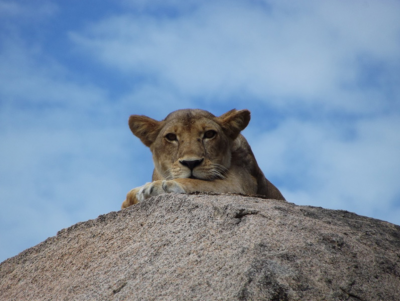News
Latest Lion Aid News
The A B C D E F G and H of needs and concerns for wild lion conservation.
Tuesday 15th August 2017
|
A recent report estimated that the geographic range of lions in Africa has declined by something like 94% over the years. LionAid has long been concerned about this free-fall decline, and we would like to list some of the reasons. Unlike other organizations we estimate that there are no more than 13,000-14,000 wild lions (in unfenced reserves) across Africa – our latest estimate comes from a survey of Angola where the IUCN and other organizations estimated a lion population of 1,000 to 1,900 lions. The survey found about 20 remaining. So here is the alphabet: A – Stands for Agriculture. In countries as far apart geographically as Ethiopia and Senegal, the borders of gazetted national parks are increasingly invaded and challenged by agriculture. In Ethiopia, such bordering lands are sold to a diversity of companies that use African land to feed people in their own lands. That is a complicated story and not to be gone in much detail here, but it is a real threat to the future of nationally protected areas. India and middle eastern counties are prime players. B – Stands for Bushmeat poaching. Nationally protected areas are being emptied of wild species via commercial bushmeat networks. Snares, spears and guns have contributed to “herbivore deserts” in some cases. Those lions not caught and killed by the snares as “by-catch” now have to turn to cattle (see below) to relieve their hunger. Bushmeat poaching could be one of the biggest but least mentioned threats to the survival of any sustainable predator population in Africa. C – Stands for Cattle. In Kenya, Cameroon, Tanzania, Central African Republic, Mali, Benin – at least - nationally protected areas are invaded by huge numbers of cattle/livestock. In some countries, rangers and wardens even profit from “entry fees” for such herds and in other countries such officials might even own a number of the cattle themselves. Cattle and predators do not form a good mix, especially when such cattle invasions result in the inevitable “retaliation” against predators. D – Stands for Disease. Lions are a highly vulnerable species from a variety of viral and bacterial diseases. Stronghold populations in Kruger National park are significantly infected with bovine tuberculosis introduced by cattle and now endemic in the buffalo population. Canine distemper infects many other lion populations and is introduced to lions by a complex network of other carnivore hosts including domestic dogs and hyenas. An immunodeficiency virus (FIV-ple) is prevalent among many of the remaining largest lion populations in Africa – adult lions are often infected at a rate exceeding 95%. E – Stands for Effectiveness. The first reports on the pan-African lion population came out in 1994 and were shocking. That report, while not complete in coverage of all lion populations, posed that no more than about 20,000 lions remained. Hunter-supported organizations came up with a concurrent estimate of 34,000. These numbers caused sufficient concern for the IUCN to organize conferences in 2006 – conference resolutions included calls for all African lion range states to implement national lion “conservation” plans. A dozen years on, such “plans” have not produced any real successes and comprehensive implemented management plans are as rare as the lions themselves. F – Stands for Funding. While the world public continually bemoans the decline of lions, little substantive or effective funding has resulted to ensure the survival of the few desperately struggling lion populations. Lions are more endangered by far than elephants, lowland gorillas, chimpanzees, white rhinos, even polar bears. Yet lions continue to sit at the back of the funding bus. G – Stands for Governments. As mentioned above, few African governments (with the exception of Botswana and perhaps Rwanda) take lion conservation as an urgent priority. Indeed, many African governments still cling to the notion that wild lions can be sustainably utilized. Western governments (some) have made a few stands here and there – Australia, France and the Netherlands have placed a ban on all lion product imports and the USA has placed strict limits. The USA requires that any trophy import has to demonstrate that the hunted lion contributed to an overall conservation “benefit”. Meanwhile, other nations like the UK, Germany, Spain, Denmark, Czech Republic, Mexico – with the SAME information available to them, continue to wag their tails when it comes to wild lion trophy hunting imports. They hide behind CITES and the EU Wildlife Trade Regulations. Sad and irresponsible. H – Stands for Hunting. Despite all evidence, a number of African lion range states (among them Tanzania, Zimbabwe, Zambia, Mozambique, Namibia - allow trophy hunting of wild lions despite all indications that such hunting has only led to declines of lion populations over the years. Inexplicably supported by a number of Universities and major NGOs and explicably supported by trophy hunting lobbies, there seems to be little will to end this activity. Sustainability is often quoted without evidence, and one organization recently published a report to the UK government stating that “Where trophy hunting is well-regulated, transparent and devolves sufficient authority to the land managers, it has the potential to contribute to lion conservation, but in many countries, poor governance and weak regulation can lead to unsustainable trophy hunting.” In other words, a statement so bland and loaded with caveats that it is surprising it was issued. Nevertheless, despite wild lion populations being in freefall decline, there is still a puzzling insistence by some that trophy hunting contributes to the conservation of the species.
Picture credit : Ruaha Carnivore Project Tags: Hunting, lions, Africa, disease, conservation, trophies, agriculture, bushmeat poaching, cattle, Categories: Events/Fundraising, Trophy Hunting, Extinction, Domesticating Animals, Wildlife Diseases |
Add a comment | Posted by Chris Macsween at 15:49




